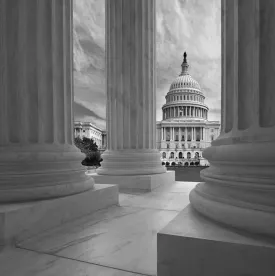In the first weeks of the 115thCongress, seeking to fulfill campaign promises made by both Congressional Leaders and President-Elect Trump, the U.S. House of Representatives passed a set of bills that would significantly alter the process by which regulations are reviewed by Congress and the courts.
Two bills are likely to form the basis for any regulatory reform efforts in Congress this session: H.R. 26, the “Regulations from the Executive in Need of Scrutiny (REINS) Act” and H.R. 5, the “Regulatory Accountability Act of 2017.”
The Regulations from the Executive in Need of Scrutiny Act
The primary purpose and effect of the REINS Act would be to shift the burden of approving regulations from the Executive Branch to Congress. Regulations would not become effective, and implementation of existing regulations would not continue, without the explicit approval of Congress.
Current Status
Representative Doug Collins (R-GA), Vice Chair of the House Republican Conference, introduced H.R. 26 shortly after being sworn in on the first day of the new session. Later that same week, on January 5, 2017, the House of Representatives passed the REINS Act by a vote of 237-187 with the support of all Republicans and two Democrats.[1] A similar bill was introduced and passed in the House in the last three sessions of Congress.
In the Senate, companion legislation has been introduced by Senator Rand Paul (R-KY) and referred to the Committee on Homeland Security and Governmental Affairs.[2] No other action has been taken in the Senate to date.
Major Provisions and Impacts
The primary feature of the REINS Act would require a “joint resolution of approval” passed by Congress and signed by the president before any major regulation—generally those having an estimated effect on the economy of greater than $100 million annually—could go into effect. If, after 70 session days, a joint resolution of approval were not enacted, the rule could not go into effect and may not be reconsidered by Congress during that session. The bill does provide that, should the President certify that the regulation is deemed necessary because of an imminent threat or national security, it can temporarily go into effect for 90 days.
Joint resolutions of approval would not be subject to amendment, could only be considered by relevant committees for up to 15 days, would not be subject to the Senate filibuster, and, in the Senate, would only be allotted 2 hours of floor debate.
Two substantive amendments were adopted during House deliberation of the REINS Act that would require additional actions by regulatory entities. Each year, agencies would have to submit a specified percentage of existing major regulations for review by the Congress under the same procedure outlined above. In order for implementation of those rules to continue, they too would require a joint resolution of approval. In addition, for each new proposed rule, agencies would have to provide for the repeal or amendment of an existing rule. The regulation repealed would be required to have at least as big an impact on the economy as the one being adopted.
There are many regulations that have estimated economic effects of more than $100 million annually. For example, in 2015, there were 66 such regulations from cabinet agencies. This does not include regulations from independent agencies, whose rules would also be subject to the REINS Act. Because each regulation would appear to need a separate joint resolution of approval, there is some risk that Congress would have to devote substantial time to approval of even noncontroversial rules. It also appears that regulations repealing existing rules would have to be approved by Congress.
The Regulatory Accountability Act of 2017
The Regulatory Accountability Act of 2017 is a collection of regulatory reform bills passed in the last Congress aimed at slowing down the federal agency rulemaking process and requiring agencies to conduct significant additional analyses before proposing and finalizing rules. Additionally, the bill would reverse what is known as the Chevron doctrine to increase the role of the courts when interpreting the agencies’ governing statutes and decrease the role of agency authority when in litigation.
Current Status
House Judiciary Committee Chairman Bob Goodlatte (R-VA) introduced H.R. 5 on the first day of the 115th Congress, alongside the REINS Act. The following week, on January 11, 2017, the House passed the bill on a largely party-line vote of 238-183. On January 12th, the House passed bill was sent to the Senate for consideration, where it was referred to the Committee on Homeland Security and Government Affairs which has not scheduled any action on the bill.
Major Provisions and Impacts
As passed by the House, H.R. 5 consists of six separate regulatory reform initiatives originally introduced as separate bills in previous sessions of Congress, including:
Title I: Regulatory Accountability Act. Title I would amend the Administrative Procedure Act in a number of consequential ways:
-
Agencies would be directed to consider a number of specified factors when deciding whether to initiate a rulemaking, including potential costs and benefits such as impacts on jobs, wages, economic growth, innovation, competitiveness, and low income populations.
-
For any rule with a substantial impact on the economy, jobs or wages,[3] agencies would be required to issue an advanced notice of proposed rulemaking and elicit public input at least 90 days before issuing a specific proposed rule.
-
Agencies would have to provide a minimum of 60-120 days for public comment.
-
Any member of the public can request a formal hearing for any agency rule regarding whether information that formed the basis of the proposed rule meets the Information Quality Act.
-
Judicial review regarding the agency’s compliance with the Information Quality Act would be authorized.
-
Agency staff would be prohibited from public communication supporting the rule or appealing to the public to advocate for the rule.
-
Formal hearings would be required for all regulations with an estimated economic impact of $1 billion or more.
-
Agencies would be required to adopt only the “least costly rule considered during the rulemaking . . . that meets relevant statutory objectives” unless the additional benefits of the more costly rule justify the additional costs. The benefits must be “within the scope of the statutory provision authorizing the rule.”
-
Agencies would be required to review rules with substantial impacts on the economy, jobs, or wages at least every 10 years. Revised cost benefit analyses would have to be published every 5 years while the rule remains in effect.
-
Agencies would be required to provide additional reasoning and explanation of guidance with significant economic impacts, including a cost-benefit analysis.
-
The Office of Information and Regulatory Affairs (OIRA) would be given authority to review agency guidance.
In general, the rules proposed in Title I would substantially extend the time for proposal and finalization of rules. This would appear to apply to regulations rescinding rules as well as those imposing new regulatory obligations. It would also impose additional informational and analytical obligations on agencies and place greater emphasis on the Information Quality Act.
Title II: Separation of Powers Restoration Act. Title II purports to eliminate the administrative law doctrine of Chevron deference. Courts are directed to review all agency interpretations of their governing statutes and regulations de novo and not presume Congress intended that deference be given to agency interpretations of ambiguities in those statutes and agency regulations adopted thereunder.
The impact of this provision is not entirely clear. Some degree of judicial deference to agency interpretations of their governing statutes and regulations adopted thereunder long pre-dated the Chevron doctrine. If this provision were enacted, it is not clear whether courts would be precluded from providing other forms of judicial deference to agency actions, and how courts might respond to previously enacted statutes that implicitly delegate authority to agencies to resolve matters within their areas of expertise (such as determining whether “reasonable assurance” that the public health and safety will be protected if the Nuclear Regulatory Commission issues a license to operate a nuclear reactor, or an economic regulatory agency determines what is a “reasonable” rate).
Title III: Small Business Regulatory Flexibility Improvements Act. Title III would expand the applicability of the Regulatory Flexibility Act, which requires analysis of the impacts of proposed and final regulations on small businesses and mitigation of such impacts if they are likely to be significant. It would apply the Regulatory Flexibility Act to regulations that indirectly affect small businesses, currently exempted federal actions such as land management plans, and certain rules under which the IRS interprets tax law. Title III would also require agencies to periodically review existing rules and expand the amount and detail of analysis required.
Title IV: Require Evaluation Before Implementing Executive Wishlists Act. Title IV would prohibit new rules that have an annual economic impact of $1 billion from going into effect until the completion of judicial review or if no judicial review is sought within 60 days. For those rules which qualify, this provision would substantially delay (likely by years) any new rule from going into effect.
Title V: All Economic Regulations are Transparent Act. Title V would require agencies to submit to OIRA a list and description of rules they intend to propose or finalize over the next year, including substantial information regarding those rules. It requires OIRA to post the submitted information. Rules would not be able to take effect until 6 months after this information is posted. OIRA would also be required to conduct an annual assessment of agency rulemaking.
Title V would expand upon practices already in place regarding the unified regulatory agency. It would impose substantial administrative burdens on OIRA staff.
Title VI: Providing Accountability Through Transparency Act. Title VI would require agencies to post to the internet a 100-word summary of any proposed rule.
Likelihood of Enactment and Next Steps
Both the REINS Act and the Regulatory Accountability Act of 2017 await action in the Senate. To date, no committee action has been scheduled and may not be expected in the immediate future as the Senate considers hundreds of nominations, repeal of the Affordable Care Act, and the FY 2017 budget and spending measure in the coming months.
Under current Senate rules, both the REINS Act and the Regulatory Accountability Act of 2017 would require 60 votes for passage before being sent for the President’s signature. While this reduces the likelihood that wholesale regulatory reform will be successful over the next year, it remains a priority for House Leadership as well as a number of large business associations.
Because of the substantial change to the regulatory process that would be contemplated by the REINS Act, it has often been described more as a “messaging” bill than as regulatory reform likely to be enacted into law. However, regulatory reform is a clear priority of the House Republican Conference and President-elect Trump. There has also been some concern among academic scholars that the REINS Act may face a constitutional challenge.[4]
While not as drastic as the REINS Act, the changes imposed on the regulatory process and judicial review of regulations by the Regulatory Accountability Act of 2017 would be significant. Such changes would require the support of at least 60 Senators and strong opposition from most Democratic Senators should be expected.
[1] http://clerk.house.gov/evs/2017/roll023.xml
[2] https://www.congress.gov/bill/115th-congress/senate-bill/21/related-bills.
[3] Title I defines different classes of rules: those that have an estimated annual economic impact of $100 million or more (“major rule”), those that have an estimated annual economic impact of $1 billion or more (“high-impact rule”), those that are expected to reduce employment or wages by 1% or more annually over a 1-10 year period in a particular industry (“negative-impact on jobs and wages rule”), and rules involving novel legal or policy issues.
[4] http://www.eenews.net/stories/1060047790; http://blogs.law.columbia.edu/climatechange/2011/02/14/questioning-the-constitutionality-of-the-reins-act-proposed-bill-seeks-to-restructure-the-federal-rulemaking-process/; https://judiciary.house.gov/_files/hearings/pdf/Katzen01242011.pdf





 />i
/>i

